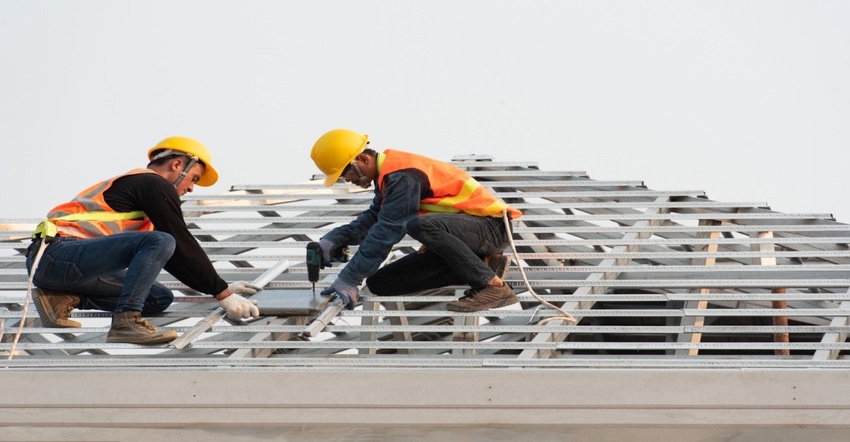Extreme weather on both coasts has inundated roofers and exacerbated supply chain challenges.
November 3, 2021

Roofers on both coasts are being “slammed” with emergency repairs thanks to historic storms in recent weeks, worsening already severe supply chain issues.
“As if the industry didn’t have enough issues. Severe weather in the Northwest and Northeast exacerbates an already difficult supply chain challenge,” confirmed Reid Ribble, NRCA’s CEO. “Even though manufacturers report record production, demand and logistics continue to plague deliveries.”
Ribble and other roofing leaders have called the supply chain issues “severe” and “historic” and they show no signs of letting up, especially as similarly severe and historic weather continues to pummel the U.S.
Roofers in the affected areas echoed Ribble’s assessment. “We’re slammed as it is with full roofs that need to get done and we’re completely up against it. The shortage of materials is just an uphill battle,” said Alex Dedes, operations manager for Portanova Roofing in Weymouth, Massachusetts.
He said rubber supplies were in particularly short supply including insulation and screw plates. In addition, he said it’s difficult to find lighter-colored shingles many customers prefer. Due to the shortage, he’s certified himself with additional manufacturers, but he’s still unable to get all the materials needed. “It delays jobs. I spent a couple of weeks just going around from hardware store to hardware store just buying up what I could,” he said.
And that was before the storm hit.
The recent nor’easter that tore through the region has only exacerbated the problem. The surprise storm brought hurricane-force winds to coastal New England, downing trees and ripping off roofs. Nearly half a million people were without power, according to reports. More than a week later, Dedes and other roofers are still trying to catch up.
“It’s horrible. It wasn’t like normal storms. I’ve never seen anything like it. We might as well have had a hurricane,” Dedes said. “Every day at 6:30 a.m. my phone starts ringing and it doesn’t stop until 6:30 at night. I can’t keep up with the calls. I’ve never seen this many trees down. It’s chaos.”
But like many roofers, Dedes has been like a superhero to his customers. In the midst of the aftermath and power outages, he pulled his own generator from his home to complete two jobs.
As bad as the nor’easter was, the storm that hit Northern California and the Northwest was arguably even worse. That storm brought record rainfall that turned forest fire-damaged areas into muddy flash floods. The “bomb cyclone” caused mudslides and blocked roads. Winds gusting to more than 60 mph tore out trees and roofs. Sacramento alone was drenched with an all-time record of more than five inches of rain, according to the National Weather Service.
Some roofers in the affected areas are so inundated with calls they’re simply no longer accepting any new work. “Due to the current backlog, we are unable to take on any new estimates for re-roofs or repairs at this time,” said the message at Kelly Roofing in Sonora, California.
The message was similar at Cal Roofing Systems in Vacaville, California. “Due to the recent storm and the excessive amount of calls we’re receiving, we’re temporarily unable to return every call for repairs,” the message said.
Since the storm, phones haven’t stopped ringing at The Lawson Roofing Company in San Francisco, said Eduardo Peugnet, in the firm’s accounts receivable department. “We’re getting to everyone but haven’t been able to catch up,” he said. “We’ll take new jobs, but we might not be able to get to you right away.”
Peugnet said his company is two to three weeks behind on being able to meet demand. He said the biggest material shortages are with commercial jobs right now. Not only is material hard to find, but also there are “headaches” because material prices went up under contract, leaving the company holding the bag.
That problem is nationwide, not just in storm-ravaged areas, according to AGC. “The prices contractors pay for construction materials far outstripped the prices contractors charge in the 12 months ending in September, despite a recent decline in a few materials prices, while delivery problems intensified,” the association reports.
As climate-change-fueled severe weather continues to intensify, it seems demand will continue to outstrip demand. In the midst of this dynamic, roofers should develop new strategies to deal with extreme weather, according to a report from JD Supra. “The construction industry is one of the most vulnerable industries to the effects of climate change due to its reliance on outdoor activities and labor. Forty-five percent of construction projects are affected by adverse weather, on a global level, resulting in billions of dollars in additional costs each year, mainly due to expensive schedule overruns,” the report said.
Meanwhile, mother nature shows no signs of letting up. Severe thunderstorms and downpours will inundate the Southeast before the system moves off the East coast, where it could potentially turn tropical, according to the latest forecast.
But even roofers dealing with the worst nature can throw at them remain cautiously optimistic. “It’s sunny and blue skies today,” Dedes said. “We’ll see what tomorrow is like.”
About the Author(s)
You May Also Like




